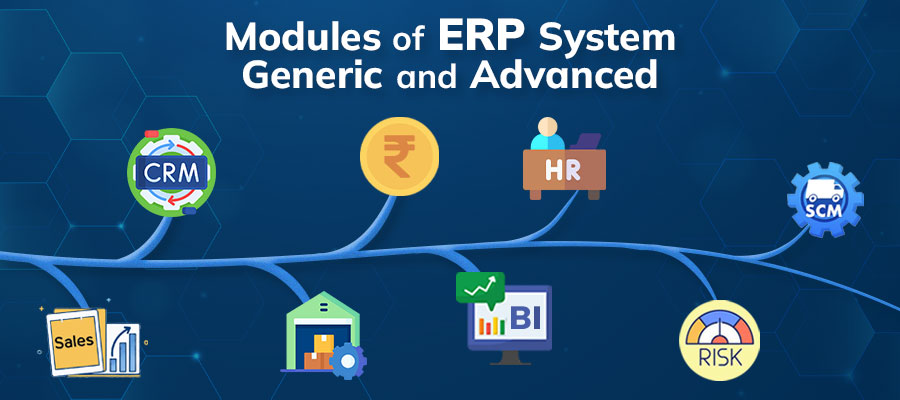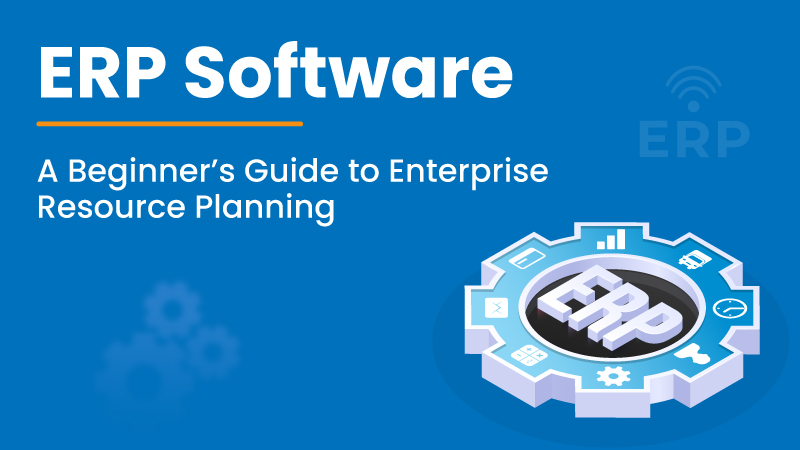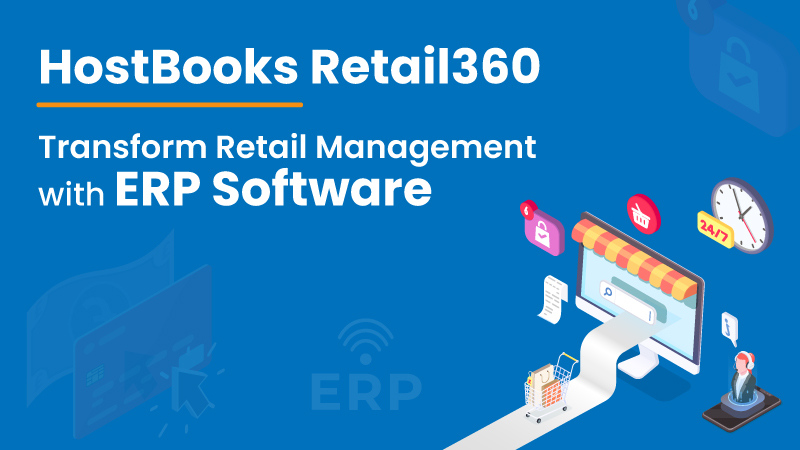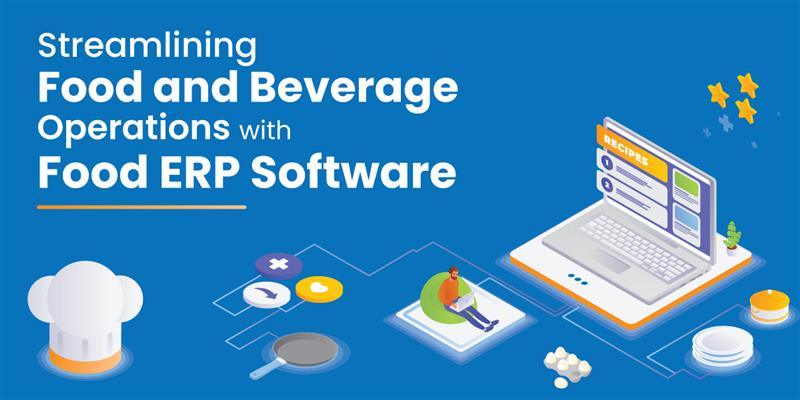Modules of ERP System: Generic and Advanced

Enterprise Resource Planning (ERP) systems are the backbone of modern business, streamlining operations and offering a comprehensive view of organizational activities. At the core of these systems are modules, specialized components working together seamlessly to manage various business functions.
Each ERP module acts as an independent application, finely tuned for specific tasks but integrated for a cohesive enterprise solution.
There could be multiple modules depending on the ERP provider or package you choose. However, there is a generic set of ERP modules present in almost every ERP, then there are advanced modules which are available on leading ERPs. Finally, there are some industry specific modules which are added on request basis or even custom developed for specific organizations.
Let’s discuss all their modules of ERP, their individual purposes, functionalities, and collective contribution to organizational success.
Generic (Basic Modules)
Generic or basic ERP modules form the core foundation of an ERP system, providing essential functionalities that cover fundamental business processes. These modules serve as the backbone for organizations, streamlining day-to-day operations, centralizing data, and facilitating seamless communication across different departments.
Finance Module
The finance module manages the core accounting and financial functions of an enterprise resource planning (ERP) system. It includes standard accounting records like the general ledger (GL) and balance sheet, generates financial reports, and handles transactions such as invoicing and expense reporting. ERPs designed for Indian businesses could have GST, Income Tax, E-Invoicing and E-way billing modules attached with the finance module.
Importance for Finance Module in ERP
Finance module is usually the first component activated in an ERP system and a key reason for organizations to switch from standalone accounting software to ERP. Integration of finances ensures accounting accuracy, meeting financial regulations, and reporting requirements, and provides consolidated financial data for performance measurement.
Features
- General Ledger: Comprehensive record of financial transactions, tracking income, expenses, assets, and liabilities.
- Accounts Payable (AP): Manages money owed to vendors, automates processes, integrates with purchasing system for better cash flow control.
- Accounts Receivable (AR): Manages money owed by customers, automates tasks like generating invoices and payment reminders for improved cash flow.
- Fixed Asset Management: Tracks and manages tangible assets, considers depreciation, compliance, and tax implications for better visibility.
- Purchasing: Basic purchasing features, paperwork generation, invoice matching for vendor invoices, may integrate with a separate procurement module.
- Risk Management: Predicts, analyzes, and manages risks to operations and financial stability, including credit risk and compliance issues.
- Reporting: Provides access to real-time financial data, supports internal and regulatory reporting, business intelligence, and analytics for data-driven decisions.
- Profit Tracking: Provides a snapshot of the overall financial health, offers visibility into profit sources, and return on investment from different sales channels.
- Tax Management: Stores tax settings, provides GST reporting and audit functions, collects tax information into a single repository.
Human Resources (HR) Module
ERP HR module (also known as HR and Payroll Module) manages human resource management for the entire employee lifecycle, centralizing employee information and processes within the ERP software. This is a super important module as companies and startups today focus more on career development and the employee experience.
Importance:
The HR module helps manage everything related to employees, including personal information, employment details, actions and events, self-service, performance reviews, compensation planning, and benefits. It integrates with other ERP components, providing employee data for various business processes like logistics and shift scheduling.
Features
- Core HR Module: Central repository for employee lifecycle, consolidating profiles, org charts, and enabling self-service actions.
- Time and Attendance: Tracks attendance, work hours, time off, and evaluates time for payroll processing, including overtime and labor rules.
- Payroll Module: Comprehensive system for payroll operations, covering tax calculations, deductions, and compliance reporting.
- Benefits Administration: Manages employee benefits, including health insurance and retirement plans, with seamless integration.
- Compensation Management: Handles compensation planning, bonus management, and variable pay programs, ensuring fair practices.
- Recruiting: Oversees entire hiring process, from requisitions to job offers, often with career websites and interview scheduling.
- Onboarding: Supports steps in bringing new employees onboard, completing compliance forms, and ensuring smooth access.
- Goals Management: Facilitates creation, assignment, and tracking of company-wide and individual goals, tightly linked with performance management.
- Performance Management: Tracks performance through goal setting, evaluations, feedback, and skill development, contributing to employee improvement.
- Career Development: Enables employees to identify future roles, career paths, and training opportunities, fostering continuous growth.
- Learning Management: Dedicated to training delivery, course catalogs, and evaluations, ensuring ongoing professional development.
- Succession Planning: Identifies key positions, plans successors, and builds talent pools for organizational continuity.
- Reporting and Analytics: Generates customizable reports and analytics on various HR metrics for strategic decision-making.
- Workforce Planning: Enables planning for current and future workforce needs, aligning staffing with strategic objectives
Integration Advantages
HR module integrated with other business processes could have some great advantages.
- Strong integration with ERP enables the use of employee data in other processes.
- Generates holistic reports and analytics combining ERP and HR data.
- Facilitates cross-ERP workflows and integrates cost center data with HR data for payroll and cost assignment processes.
- Aligns staff scheduling with business needs in logistics or distribution modules.
- Supports workforce planning, upskilling, reskilling, job position budgets, and recruitment based on business needs.
Supply Chain Management (SCM) Module
The Supply Chain Management (SCM) module is a comprehensive system designed to facilitate planning, coordination, and collaboration across various business functions, ensuring the efficient movement of products or services from raw materials to end customers. This module encompasses five crucial components: planning, sourcing, manufacturing, delivery, and returns.
Importance of the SCM Module
The SCM module is indispensable for achieving business success by significantly influencing customer satisfaction and operational efficiency. It transforms supply chains into strategic assets, contributing to competitive advantages through cost reduction, enhanced speed, and adaptive responsiveness to disruptions.
Features
- Planning: The foundational feature of the SCM module involves advanced supply chain planning, utilizing software for accurate demand forecasts, analytics, and resource allocation to meet expected demand efficiently.
- Sourcing: The SCM module streamlines the identification and management of suppliers, manufacturers, and distributors. It emphasizes building resilient relationships and redundancy to ensure a stable supply chain, including the strategic management of multiple suppliers.
- Manufacturing: This feature addresses the acquisition of goods, quality inspection, and packaging for shipment. Whether involving in-house manufacturing or outsourcing, the SCM module ensures the necessary capacity and streamlined production to meet demand effectively.
- Delivery: The SCM module oversees the final stage of the forward supply chain, including order organization, prioritization, and timely delivery. Efficient order management, along with invoicing and payment collection, ensures a seamless flow of goods or services to customers.
- Returns: The returns feature manages the reverse logistics process efficiently. It addresses returned products by either scrapping, repairing, or returning them to inventory, with a clear returns policy enhancing overall customer satisfaction.
- Supply Chain Performance Tracking: This feature involves establishing Key Performance Indicators (KPIs) and metrics for real-time monitoring of operational performance. The SCM module tracks productivity, costs, fill rates, on-time delivery, and customer satisfaction, enabling prompt issue identification and resolution.
Trends in SCM Module
- Digital Supply Chain: Emphasizes near-real-time visibility for supplier performance and customer needs through digital technologies.
- Localization: Increasing focus on localizing supply chains for flexibility and responsiveness, especially in response to global disruptions.
- Sustainability: Integration of eco-friendly practices in sourcing, manufacturing, and recycling to meet customer expectations.
- Automation: Adoption of advanced automation, including robotics and autonomous vehicles, to enhance efficiency and reduce labor costs.
- Circular Supply Chains: Promotion of circular supply chain models, emphasizing reuse, recycling, and waste reduction, aligning with sustainability goals.
Customer Relationship Management (CRM) Module
A Customer Relationship Management (CRM) module in ERP refers to the system that is designed to manage and streamline an organization's interactions with its customers throughout the entire customer lifecycle. The primary goal of a CRM module is to improve customer relationships, enhance customer satisfaction, and drive sales growth.
Importance of CRM Module:
The CRM module offers significant benefits, including improved database management, enhanced client relationships through comprehensive access to ordering history, increased data clarity for team collaboration, and greater customer retention achieved by involving multiple sales team members in customer relationships.
Key Features
- Lead and Opportunity Management: Equips the sales team with tools for accurate revenue forecasts, automated tasks, and synchronization with Microsoft® Office.
- Contact Management: Facilitates communication documentation and sharing, enhancing focus and responsiveness through task management tools.
- Customer Connect: Provides customers with interactive content, special promotions, price lists, repeat purchase options, and convenient payment methods.
- Marketing Management: Enables contact import, automated targeted emails, and tracks marketing campaign success for easy monitoring and reporting.
- Marketing Automation: Automating marketing tasks and campaigns to enhance lead generation and customer conversion.
- Case Management: Empowers customer support with tools for standardized issue resolution, searchable online answer books, and efficient dispatching activities.
- Mobile CRM: Ensures mobile access to the entire CRM suite, allowing employees to manage leads, customers, contacts, quotes, orders, and more on the go.
- Integration with Other Software: Facilitates seamless creation and management of customer records, ensuring automatic updates between systems for a streamlined sales process.
- Sales Force Automation: Automating sales-related functions to streamline the sales cycle and build customer loyalty.
- Analytics: Analyzing customer data to identify trends, insights, and opportunities for targeted marketing campaigns.
Sales and Procurement Module
Advanced Modules
Advanced ERP modules represent a sophisticated layer of the ERP system, offering specialized functionalities that go beyond the basic operations. These modules often cater to specific industry requirements or complex business processes.
Advanced ERP modules enhance organizational capabilities by providing deeper insights, automation of intricate tasks, and targeted solutions tailored to the unique needs of the business.
Project Management Module
A Project Management Module is a pivotal component within Enterprise Resource Planning (ERP) systems, dedicated to efficiently overseeing and coordinating various aspects of project lifecycles. This module is designed to enhance organizational productivity, collaboration, and the successful execution of projects from inception to completion.
Importance of Project Management Module:
The Project Management Module plays a crucial role in optimizing workflows, ensuring resource allocation, and fostering collaboration among team members. By providing a centralized platform for planning, executing, and monitoring projects, it significantly contributes to meeting deadlines, controlling costs, and achieving project objectives.
Key Features of the Project Management Module:
- Task and Resource Allocation: Enables precise assignment of tasks and allocation of resources, ensuring optimal utilization and productivity throughout the project.
- Gantt Chart Visualization: Utilizes Gantt charts to visually represent project timelines, milestones, and dependencies, aiding in comprehensive project planning and management.
- Collaboration Tools: Facilitates seamless communication and collaboration among team members, allowing for real-time updates, file sharing, and discussion threads within the project environment.
- Budgeting and Cost Management: Provides tools for budget creation, expense tracking, and financial management, ensuring projects stay within allocated financial constraints.
- Risk Assessment and Mitigation: Identifies potential risks associated with the project and implements strategies for risk mitigation, helping to proactively address challenges before they escalate.
- Document Management: Centralizes project-related documentation, making it easily accessible to team members, fostering transparency, and ensuring everyone works with the latest information.
- Reporting and Analytics: Generates comprehensive reports and analytics on project progress, resource utilization, and other key performance indicators, aiding in informed decision-making.
- Timeline and Deadline Management: Helps in setting realistic timelines, managing deadlines, and sending automated reminders, ensuring the project stays on track.
- Integration with Other Modules: Seamless integration with other business modules such as CRM, HR, and finance, providing a holistic view of organizational processes and resources.
- Customizable Workflows: Adapts to diverse project requirements with customizable workflows, allowing organizations to tailor the system to their specific project management needs.
Warehouse Management Module
The Warehouse Management Module plays a vital role in streamlining how businesses handle, store and retrieve their stocks, raw materials, or work in progress. It focuses on making sure products are more efficiently through the warehouse, from arrival to shipping. It includes telling users how much to store, order and where to store a specific batch.
Importance of Warehouse Module
This module contributes to the effective utilization of warehouse space, accurate inventory tracking, and timely order fulfillment. By providing real-time visibility into warehouse activities, it enhances operational efficiency, reduces errors, and improves overall customer satisfaction.
Key Features of the Warehouse Management Module:
- Inventory Tracking and Control: Enables real-time tracking of inventory levels, ensuring accurate stock counts and reducing the likelihood of stockouts or overstock situations.
- Order Processing and Fulfillment: Streamlines the order fulfillment process, from order receipt to packing and shipping, ensuring timely and accurate deliveries to customers.
- Barcode Scanning and RFID Integration: Utilizes barcode scanning and Radio-Frequency Identification (RFID) technology to enhance the accuracy of inventory management and reduce manual errors.
- Space Optimization: Efficiently utilizes warehouse space by providing insights into optimal storage locations, minimizing unnecessary movement, and maximizing storage capacity.
- Supplier Collaboration: Facilitates communication and collaboration with suppliers for efficient procurement, order processing, and timely replenishment of stock.
- Real-time Analytics: Provides real-time analytics on warehouse performance, order processing times, and inventory turnover rates, aiding in data-driven decision-making.
- Returns Management: Manages the process of product returns efficiently, ensuring accurate documentation, inspection, and restocking of returned items.
- Cross-Docking Support: Optimizes logistics by facilitating cross-docking processes, minimizing storage time, and expediting the transfer of goods directly from receiving to shipping.
- Compliance and Regulatory Support: Ensures compliance with industry regulations and standards related to inventory management, labeling, and safety within the warehouse.
- Integration with Other Modules: Seamlessly integrates with other business modules, such as sales, procurement, and finance, providing a holistic view of supply chain operations and business processes.
Business Intelligence (BI) Module
The Business Intelligence (BI) Module is a component within an enterprise resource planning (ERP) system designed to analyze and present business data for decision-making purposes. It focuses on transforming raw data into meaningful insights, helping organizations understand trends, identify opportunities, and make informed decisions to enhance overall business performance.
Importance of Business Intelligence (BI) Module:
The BI Module empowers organizations by converting complex data sets into understandable visualizations and reports. It enables stakeholders to identify trends, make strategic decisions, and respond to market changes promptly.
Key Features
- Data Visualization: Presents data in visually appealing charts, graphs, and dashboards, making it easier for users to comprehend complex information.
- Ad Hoc Reporting: Allows users to create custom reports on-demand, tailoring analyses to specific business needs without relying on IT support.
- Predictive Analytics: Utilizes advanced analytics to forecast trends, helping businesses proactively plan and strategize for the future.
- Real-time Analytics: Provides up-to-the-minute insights, ensuring that decision-makers have access to the most current data.
- Data Integration: Aggregates data from various sources, including internal databases and external systems, to create a comprehensive view of business operations.
- Customizable Dashboards: Allows users to tailor dashboards to their preferences, focusing on key performance indicators (KPIs) relevant to their roles.
- Mobile Access: Facilitates access to business intelligence on mobile devices, ensuring that stakeholders can make informed decisions on the go.
- Collaborative Analytics: Promotes collaboration by allowing teams to share insights, annotations, and comments within the BI platform.
Compliance and Risk Management Module
The Compliance and Risk Management Module is an integral part of a comprehensive ERP system, designed to proactively protect enterprises by ensuring the security of financial data and streamlining compliance processes. This module plays a crucial role in building trust and resilience, particularly in the face of constant change and disruption.
This module is designed to centralize audits, Key Performance Indicators (KPIs), incidents, and documentation requirements, ensuring comprehensive compliance across various quality standards.
Importance
The Compliance and Risk Management Module is essential for overseeing organizational adherence to diverse regulations and ethical standards, including tax compliance (GST, TDS, Income Tax Rules), Companies Act, The Banking Regulation Act, Insurance Act, and SO ON. Its significance lies in enabling End-to-End Compliance Management by automating audits, KPIs, incidents, documentation, and continuous compliance assessment, covering audit planning, execution, and reporting. The module ensures adherence to industry-specific Quality Standards for trust and confidence.
Key Features
- Complete Compliance Management: This feature automates processes for enhanced efficiency, supports integration with existing systems, and offers customization for specific organizational processes and compliance requirements.
- Quality Standards: The Quality Standards Dashboard allows businesses to assess and schedule audits for compliance with various quality standards.
- Key Performance Indicators (KPIs): Utilizing both qualitative and quantitative KPIs, this feature measures progress, enables historical data comparison, and translates technical KPIs into a business-friendly language.
- Document Management System (DMS): The DMS ensures effective record management, team collaboration, and compliance with document requirements.
- Audit Management: Simplifying audit workflows, this feature organizes collaboration cycles among audit teams.
- Tax Compliance: Focused on managing taxes efficiently, this feature incorporates cross-module tax-return functionality. It ensures global tax compliance, covering Income Tax and GST systems, providing support for organizations with diverse tax obligations.
- Financial Reporting: Streamlining financial reporting, this feature supports compliance with GAAP, IFRS, and local regulations globally.
- Custom Protections and Audit Trails: Ensuring the integrity of financial reporting, this feature integrates e-signatures, custom role-based permissions, and addresses regulatory compliance.
- Business Process Automation and Modeling: Enabling modeling and documentation of key processes, this feature enhances visibility into operations.
Asset Management Module
The Asset Management Module in an ERP system streamlines the tracking, maintenance, and utilization of organizational assets. It provides a centralized database for efficient monitoring of equipment, facilities, and resources, facilitating better decision-making and resource optimization.
Importance: Effective asset management is crucial for cost control, risk mitigation, and operational efficiency. The Asset Management Module ensures accurate real-time data, enabling organizations to maximize asset lifespan, minimize downtime, and comply with regulatory requirements.
Key Features:
- Asset Tracking: Comprehensive tracking of assets from acquisition to disposal, ensuring accurate record-keeping.
- Maintenance Scheduling: Automated scheduling for preventive maintenance, reducing unplanned downtime and extending asset lifespan.
- Depreciation Management: Precise calculation and tracking of asset depreciation, aiding in financial reporting and compliance.
- Integration: Seamless integration with other ERP modules for holistic data flow and better decision support.
- Barcode/RFID Support: Efficient identification and tracking of assets using barcodes or RFID technology, enhancing accuracy and speed.
- Alerts and Notifications: Proactive alerts for maintenance tasks, warranty expirations, and other critical events, ensuring timely actions.
- Reporting and Analytics: Robust reporting tools for insights into asset performance, utilization, and financial impact.
- Compliance Management: Ensuring adherence to regulatory requirements through automated compliance checks and documentation.
Workflow Management Module
The Workflow Management Module in an ERP system orchestrates and optimizes business processes, ensuring seamless coordination and collaboration across departments. It provides a structured framework for defining, executing, and monitoring workflows, enhancing organizational efficiency.
Importance of Workflow Management Module
Efficient workflow management is vital for improving productivity, reducing bottlenecks, and enhancing communication within an organization. This module streamlines processes, minimizes errors, and accelerates decision-making, contributing to overall operational excellence.
Key Features:
- Process Automation: Automation of repetitive tasks and standard processes, eliminating manual errors and accelerating task completion.
- Task Assignment and Tracking: Clear assignment of tasks to individuals or teams with real-time tracking, promoting accountability and visibility.
- Approval Workflows: Defined approval processes for various activities, ensuring compliance with organizational policies and reducing delays.
- Collaboration Tools: Integration of communication tools, file sharing, and discussion forums within the workflow for seamless collaboration.
- Customization: Flexibility to design and customize workflows based on specific organizational requirements, accommodating diverse processes.
- Notification System: Real-time notifications and alerts for task deadlines, updates, or any deviations from the predefined workflow.
- Analytics and Reporting: Comprehensive reporting tools providing insights into workflow performance, bottlenecks, and process optimization opportunities.
- Integration with Other Modules: Seamless integration with other ERP modules, such as HR, Finance, and Project Management, ensuring end-to-end process visibility and data consistency.
Conclusion
The modules of an ERP system serve as the fundamental building blocks that, when integrated, automated, and streamlined, create a robust and comprehensive solution for managing various aspects of business operations. The generic and advanced modules discussed above represent the common components found in most ERP systems.
However, it's essential to note that the modular nature of ERP allows for customization based on the specific needs and requirements of different businesses and industries. In practice, organizations may implement additional modules tailored to their unique processes, ensuring the ERP system aligns seamlessly with their operations.
FAQ Section
What are the 5 components of ERP?
- Software: The core ERP application that manages and integrates business processes.
- Hardware: The physical devices and servers necessary to host and run the ERP software.
- Database Management System (DBMS): The software that handles data storage, retrieval, and management.
- Network: The infrastructure that connects various components and allows data to flow between them.
- People: The users, administrators, and other stakeholders involved in the ERP system's implementation and operation.
What are the three basic categories of ERP modules?
The three basic categories of ERP modules are commonly classified as:
- Core Modules: Essential for most ERP systems, covering basic business functions like Finance, HR, SCM, and Manufacturing.
- Advanced Modules: Offer sophisticated functionalities such as BI, Workflow for organizations seeking advanced features.
- Industry-Specific Modules: Tailored to meet unique requirements of specific industries, ensuring alignment with sector-specific practices.
What are the three main modules of ERP?
The main modules of ERP could differ based on requirements however every ERP typically include:
- Finance Module
- Human Resources (HR) Module
- Procurement and Sales Moudle
Is SAP ERP a Module?
SAP ERP is not a module itself, but a comprehensive ERP software suite developed by SAP SE. SAP ERP consists of various modules that organizations can implement based on their business needs, such as SAP Finance, SAP HR, SAP SCM, etc.
What is the ERP life cycle?
The ERP life cycle involves stages such as Planning, Selection, Design, Implementation, Testing, Deployment, and Maintenance. It is a continuous cycle of improvement and adaptation to changing business requirements.
Which Module is Best in ERP?
The "best" ERP module depends on the specific needs and priorities of a business. For example, Finance modules are crucial for financial management, while Manufacturing modules are vital for production-oriented businesses. The best module is determined by the nature of the business and the desired outcomes.

Try HostBooks
SuperApp Today
Create a free account to get access and start
creating something amazing right now!

















